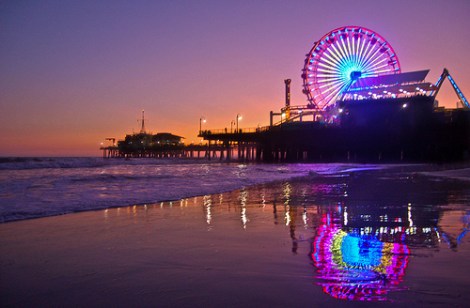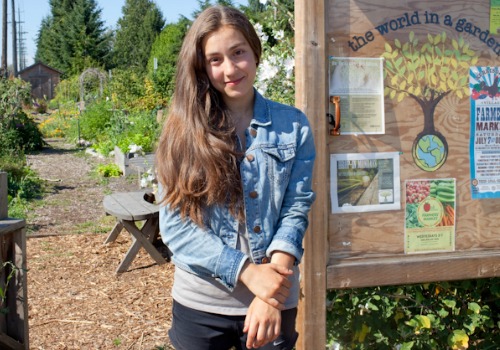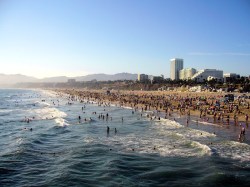Before you write off Santa Monica as a surf camp for liberals, lend an ear to the city’s assistant director of the Office of Sustainability and the Environment, Shannon Parry. “People always say, ‘Of course you can do that. You’re Santa Monica.’ One of the things we always say is, ‘Santa Monica hasn’t always been Santa Monica,’” she says. “This was Dogtown. This was dilapidated piers, burnt-out buildings, and skate rats.”
The city, surrounded on three sides by Los Angeles, still has its share of regional problems — air quality, traffic, homelessness — but its Dogtown days are long over. Cleaning up the beaches increased tourism, a major contributor to the local economy. And the city, population 89,000, is now home to the corporate headquarters of big players like Lionsgate Films and Universal Music Group. “Fortunate People in a Fortunate Land” indeed.
Parry says Santa Monica’s active and engaged community deserves the credit for where the city is today. Residents show up at city council meetings and events and vote in droves. In the last off-cycle election, the city had 65 percent voter turnout. “The things we think of Santa Monica being now are really things this community has said are important and makes happen,” Parry says. And for nearly 20 years, Santa Monicans have made a concerted effort to green their city.

Shannon Parry.
Parry’s own story is full of fortune, too. While working as a mountain guide, the velcro peeled off her Patagonia bag. When she returned it, she got to talking with the Patagonia salesperson about how she desperately wanted to get a job in sustainability but didn’t know where to start. The employee gave her a tip about a job with a Santa Monica nonprofit. One job led to another, and a few years later, she got to tell her tale to Patagonia founder Yvon Chouinard at Santa Monica’s Sustainable Quality Awards. She thanked him for launching her career with a faulty product.
In this fifth installment in our Knope and change series, I talked to Parry about Santa Monica’s bike valet program, Keanu Reeves, and what a ferris wheel can teach us about solar power.
Q. A large number of your residents are employed in the creative sector. In your most recent sustainability plan [PDF], you added arts and culture goals. How are arts and culture linked to sustainability?
A. Arts and culture reflect the creativity and the intensity and the vibrancy that are really at the core of a sustainable city. People are always talking about the triple bottom line, the three-legged stool. We’ve got economy and we’ve got environment and we’ve got people. But people rarely ask, “What are those three legs of the stool holding up?” To me, those three legs of the sustainability stool are holding up the cultural identity of your community, where people come to live and work and play. I started thinking about it and realized this needs to be reflected in a meaningful way in our plan. We need to be integrating and calling out and celebrating and nurturing this aspect of our community, which is foundational to our identity and successes.
Q. A few years ago, sustainability was the national cause du jour. Has the mood changed in Santa Monica?
A. Our sustainability program was first adopted by the city council in the mid ’90s. Sustainability here is less of a trend and more of a way of life. We haven’t had the same backlash other communities are having around ICLEI [Local Governments for Sustainability] or Agenda 21. In fact, we have a councilmember who is on the board of ICLEI.
Q. You’ve been doing some interesting things with bicycling.
A. We have a community bike valet. One guy [Luis “Lumo” Morris] is the heart and soul of our bike valet program. They parked 24,000 bikes for free at more than 200 community events. You come down to the Santa Monica Pier — throughout the year we have concert series and movie screenings on the pier — and there’s a bike valet. Thousands of bikes are being parked for free at community meetings, at schools, at city hall. One of our early adopters is Ale House in our main street district. They worked with Lumo and the city to have recurring Friday night bike valet so people could have easy access to the beach and downtown district.
Q. What else has Santa Monica been up to?
A. We recently expanded our food waste program beyond commercial business collection to curbside bins. In the first year the [expanded] program was here, we eliminated 4 million pounds of waste from the landfill.
We banned single-use plastic bags and eliminated single-use polystyrene from food containers and added a whole sustainable foods program. More than a million people a year shop at our four farmers markets.
We have the first solar-powered ferris wheel in the country on the end of our pier. If you look at the pier from the south side and you look up at the amusement park with a roller coaster and those kind of classic, fantastical amusement park attractions, right in the middle of them is the sun glistening off these solar panels that run the ferris wheel.

red.dahliaLED lights glow on the Santa Monica ferris wheel. (The original wheel was replaced several years ago.)
Q. When people claim that solar power is unreliable, you can show them people willing to get on a ferris wheel that’s run on solar.
A. To the best of my knowledge, we haven’t had to walk anyone down from the top yet. At least not for that reason.
So often people say, “We need these things to be invisible so people aren’t thinking about being in a green city or a sustainable city.” But if you get on the ferris wheel and you see the solar panels, you can see that your ferris wheel is functioning. Your world is still going by exactly how you thought it would. I actually think there is great utility in making sustainable features very visible.
Our urban runoff and [water] recycling facility could have been situated in any number of locations. They chose [a] beachfront location. It can treat 64 million gallons of urban runoff annually. It’s bright blue and red and yellow and has public art integrated into it and it has a sustainability walking tour. People who are coming from the downtown to the beach walk through it.
Q. Your public transportation — the Big Blue Bus — was featured in the 1994 flick Speed, starring Keanu Reeves. Did that drive any interest in Santa Monica or its public transportation?
A. That is an excellent question. I have no idea if there was any kind of fallout positive or negative from that film. I’m going to ask around now though.
Q. There has to be someone who did their doctorate on it back in the day.
A. One of our staff members is always saying, “What’s that sexy indicator? What’s that pop culture data point that’s going to encapsulate what we’re trying to do? What’s going to draw an even larger group of people into our efforts?” Maybe I’ll suggest a six-degrees-of-separation of Keanu Reeves from Santa Monica on film.




